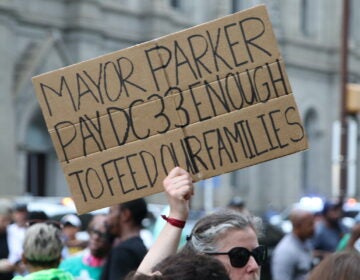NABJ addresses controversy, diversity at conference
As its members gather in Philadelphia for their annual conference, the National Association of Black Journalists is in the midst of controversy. Earlier this year, the NABJ quit a coalition of minority journalism groups called Unity. Now three associations remain — representing Asian American, Hispanic and Native American journalists. The NABJ had contributed the majority members to Unity.
Deirdre Childress, a NABJ vice president and candidate for the association’s presidency, said leaving Unity was a financial decision. “When NABJ is bringing 52 percent of then money to an an agreement, we need to know how that money’s being spent,” said Childress, an entertainment editor with the Philadelphia Inquirer. “It’s like if you’re the majority shareholder in a company and, every time you go into a meeting, no one listens to you. That can’t work out. Then you’re going to pull your investment.”
Critics say the move unnecessarily divides the community of minority journalists. On Friday, NABJ member passed a resolution to re-examine the decision by the end of August. Childress says with a decreasing number of minorities in newsrooms, she hopes they can resolve lingering financial questions and reaffirm their common cause. “I think we’re all going to try to figure something out because the main enemy here is the lack of diversity at many news organizations,” she said.
For the third year in a row, the minority representation in newsrooms has declined, while the number of journalism jobs has risen. A student program at the conference is mentoring the next generation of journalists to help reverse that decline.
Ken McFarlin, an art director at the New York Times, was giving pointers to a group of African American journalism students at the conference on Friday. They were critiquing the design of a newspaper they produced with local stories and conference news.
About 30 students from around the country were getting a crash course in editing video, producing online content and writing copy that appears on actual newsprint during the weekend conference. Each team has a mentor such as McFarlin. “It’s kinda like giving birth. It’s very difficult at times. It’s labor intensive but when it’s out, when it’s finished, your short-term memory goes,” he said.
CNN reporter Sarah Hoye, who oversees the student program, acknowledged the diversity issue.
“Do we need to make sure we’re looking at people with different backgrounds in our newsrooms to represent the communities we cover? Absolutely,” she says. “If you’re in a city where population is 90 percent black, your journalism staff should reflect that.” Hoye says diversity can be achieved by hiring young journalists with multimedia skills like the many who surrounded her Friday at the conference.
WHYY is your source for fact-based, in-depth journalism and information. As a nonprofit organization, we rely on financial support from readers like you. Please give today.




